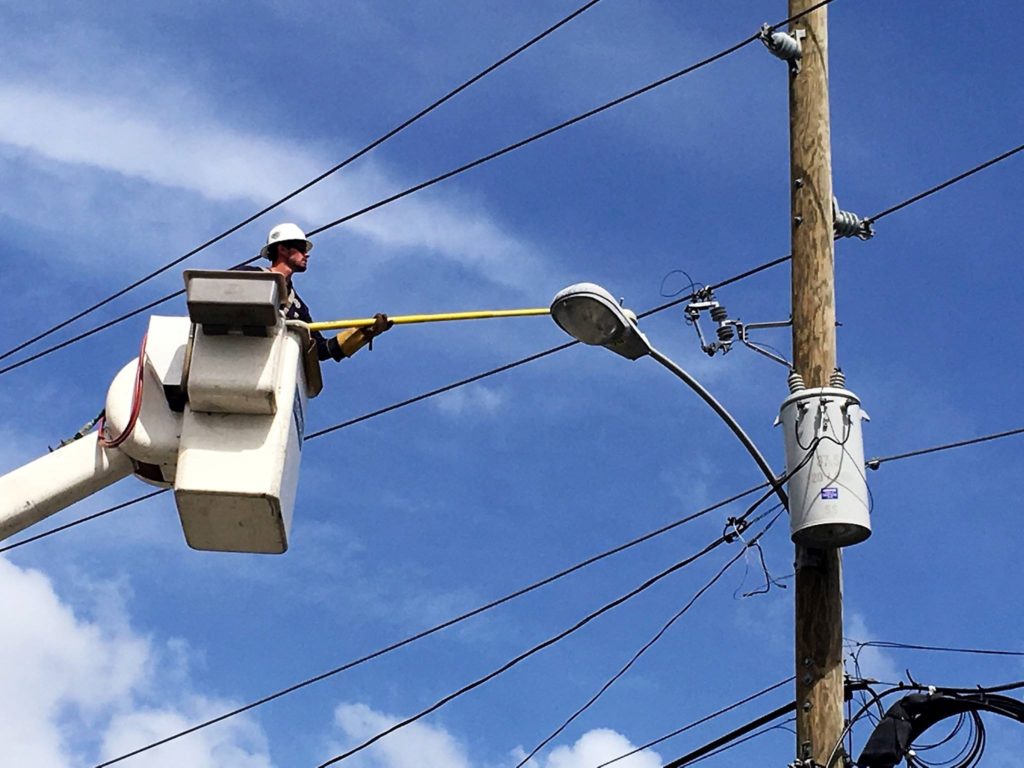WAPA JOKESTERS: Virgin Islands Water and Power Authority (WAPA) crews demonstrate the losing techniques that have left the majority of customers on each island without electricity. One lineman, Jason Julius on St. Thomas, accidentally eletrocuted himself to death after Hurricane Irma.
CHARLOTTE AMALIE — Weeks after the second of two Category 5 hurricanes tore through the Virgin Islands, New England crews are on the scene among those working to help restore power to the Caribbean territory.
Scott Edwards, general manager of the Littleton, Mass. Electric Light Department, is leading a 41-person team providing mutual aid to the territory, overseeing the painstaking effort to repair electricity infrastructure in an area where wind gusts up to 135 mph ripped poles out of the ground.
Edwards was on the eastern edge of St. Thomas last week. Speaking by phone, he said he still observed widespread devastation roughly six weeks after Hurricane Irma and a month after Hurricane Maria hit.
“You go to some neighborhoods and they’ve held up pretty well, maybe a porch torn off,” Edwards said. “And then you go into other neighborhoods and the houses are all destroyed.”
In total, 41 members of 16 public power utilities from Massachusetts, Connecticut and Vermont are under Edwards’s supervision in the Virgin Islands. Edwards is the New England coordinator of the American Public Power Association’s mutual aid program, which organizes responses to disasters.
The crews arrived on Oct. 16 with 30 trucks and pieces of equipment, hoping to assist the local electric department with what Edwards described as a “daunting” task.
Each day, he manages cooperation between the New England crews, Virgin Islands Water and Power (WAPA) workers and Federal Emergency Management Agency (FEMA) staff.
The repairs move one step at a time, spooling out meticulously as infrastructure is repaired.
“We’re starting at a substation, and you just have to start working your way out, setting poles, picking up wire, setting new wire,” Edwards said. “It’s basically one pole at a time.”
Recovery has been challenging on the islands. Official statistics are not clear, but many are without power and easy access to drinking water more than a month after the second storm hit. The territory’s official water and power authority said an initial wave of restorations would come this week.
Edwards estimated that about 20 percent of St. Thomas and St. Croix have power, mostly from downtown areas that have underground infrastructure.
In 1995, Edwards also traveled to the territory to provide aid after Hurricane Marilyn. But following Irma and Maria, he said, the conditions are “much worse,” with poles down, wires in the street and debris scattered across the road.
Among Edward’s team are four other employees of LELD, and personnel from Groton and Ashburnham.
With hope, Edwards said the majority of power will be restored by late November.
“It goes relatively quickly to get from 20 percent to 80 percent,” he said. “The last 20 percent is difficult because there’s a lot of damage to the buildings, so they have to get secondary services, electricians in to fix it.”
Despite the challenges, Edwards said he was impressed by the tenacity of the territory’s roughly 100,000 residents. Almost all have been friendly and thankful for the assistance, he said.
“Their lives go on,” he said. “They haven’t had power for six weeks. They know some areas aren’t going to get it for another six, eight, ten weeks. They just make due. They figure out a way to carry on.”
The current team will stay here through Nov. 6, at which point a second wave will deploy in their place. If further help is still needed three weeks after that, a third wave will come in.
And if that third wave is needed, Edwards will be there, too.


